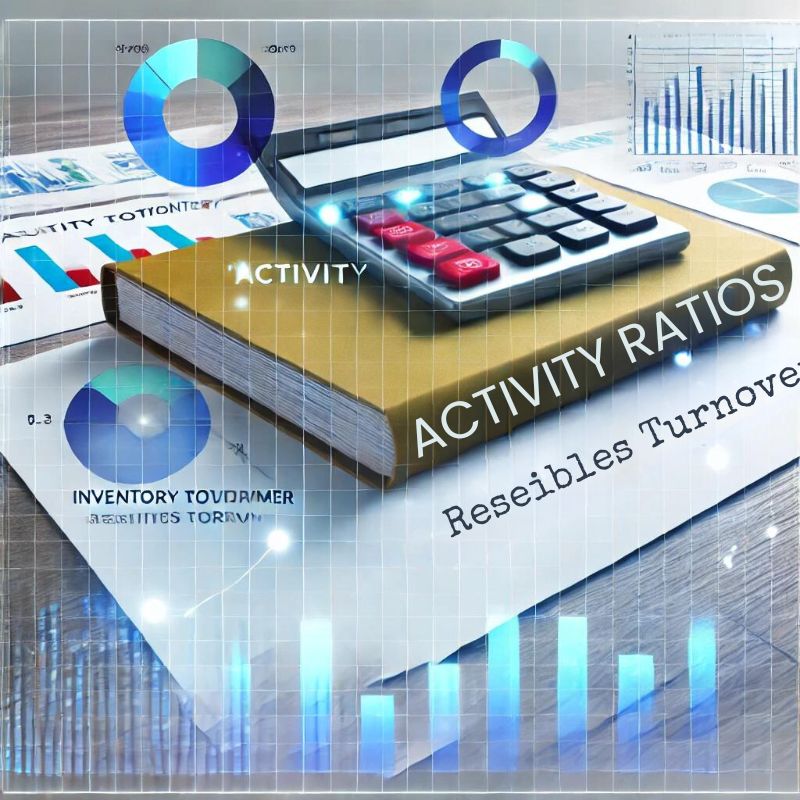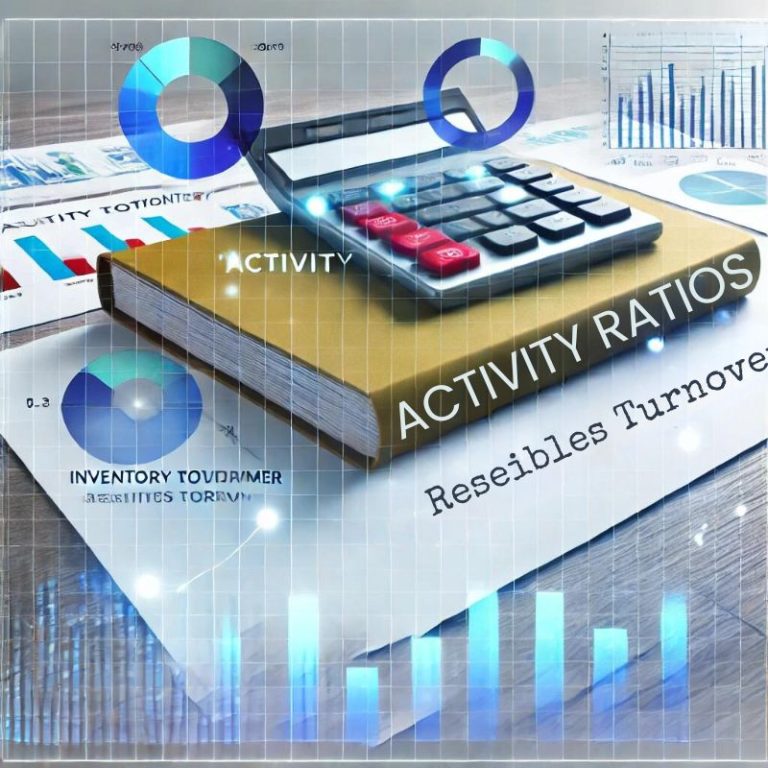Activity ratios represent significant financial metrics in accounting and finance, focusing on determining the efficiency of a company’s utilization of its assets toward revenue generation. Activity ratios help in the insight of operations by measuring various aspects of a firm’s operations, among them being inventory turns through sales and cash collection from customers. These ratios allow managers, investors, and creditors to get an insight into how well an organization carries out its activities of managing its assets; such findings impact profitability, liquidity, and the health of the business generally.
Simply put, a company with high activity ratios is often viewed as very efficient in terms of how best its resources are utilized. On the other hand, a company with lower ratios would require a re-evaluation of its operations strategy. Further, activity ratios provide a much more accurate view of working capital management by the company and how a healthy cash flow can be maintained. Activity Ratios: In detail In the following paragraphs, we will discuss activity ratios, their types, importance, and how they are calculated.
What is an Activity Ratio?
An activity ratio is a type of financial metric measuring the efficiency of a company in using its assets to generate revenue or cash. Such ratios, also known as efficiency ratios or turnover ratios, are used to measure how efficiently the resources are being put to use. Generally, some of the most common assets analyzed under this ratio include inventory, accounts receivable, and fixed assets.
Such working perspectives accompany the importance of these ratios to stakeholders. For example, a ratio of inventory turnover would disclose how fast the company sells its inventory, while an accounts receivable turnover ratio would indicate how fast a company collects credit sales. Proper management of assets is important to maintain liquidity, reduce costs, and enhance profitability.
Importance of Activity Ratios
- Operational Efficiency: High activity ratios indicate that the company is using its assets effectively to get sales, thus higher profitability.
- Liquidity: The company can manage assets like inventory and receivables effectively, which increases cash flow and thus can fulfill its short-term obligations.
- Benchmarking: These can be used to compare a company with peers to identify areas of improvement.
- Decision Making: It enables the investors, creditors, and management to evaluate the health and the working performance of the company in order to make effective decisions.
Types of Activity Ratios
There are several types of activity ratios, each focusing on different aspects of a company’s operations. Here’s a closer look at the most commonly used ratios:
Inventory Turnover Ratio
The inventory turnover ratio measures how often a company sells and replaces its inventory within a given period. A higher inventory turnover ratio means that a company is selling goods quickly, which is generally a positive indicator of business efficiency. On the other hand, a lower ratio could indicate overstocking, obsolete goods, or inefficiencies in managing inventory.
Inventory Turnover Ratio = Cost of Goods Sold (COGS) / Average Inventory
Example:
If a company has a cost of goods sold (COGS) of $500,000 and an average inventory of $100,000, the inventory turnover ratio would be:
500,000 / 100,000 = 5
This means that the company sells and replenishes its inventory five times a year.
Significance:
- A high ratio usually means that it is very well controlled in terms of inventory, with a lesser holding cost, and gets converted into sales very quickly.
- A low ratio may indicate idle inventory, slow sales, or even inaccuracy in forecasting, which may lead to high storage costs and lower liquidation.
Accounts Receivable Turnover Ratio
The accounts receivable turnover ratio is an indicator of whether the firm collects cash from its credit customers promptly. It shows to what extent the account receivables are collected. A very high accounts receivable turnover ratio means that the company collects its outstanding accounts quickly, thus improving cash flow and reducing bad debts.
Accounts Receivable Turnover Ratio = Net Credit Sales / Average Accounts Receivable
Example:
A company with net credit sales of $1,200,000 and average accounts receivable of $240,000 will have an accounts receivable turnover ratio of:
1,200,000 / 240,000 = 5
This means the company collects its receivables five times a year.
Significance:
- A high ratio will indicate prompt collection, thus better liquidity, and a lesser chance of having uncollectible accounts.
- A low ratio may reflect lenient credit policies, slow collections, or the existence of problems with customer payment terms that may hinder cash flow.
Accounts Payable Turnover Ratio
The accounts payable turnover ratio measures the pace at which a company pays off its suppliers. The higher the ratio, the faster the company pays off the suppliers’ debts-an excellent indicator of maintaining a healthy relationship with the suppliers. A low ratio may indicate financial distress or poor cash management.
Accounts Payable Turnover Ratio = Net Credit Purchases / Average Accounts Payable
- Example:
If a company has net credit purchases of $800,000 and average accounts payable of $200,000, the accounts payable turnover ratio will be:
800,000 / 200,000 = 4
This means the company settles its accounts payable four times per year.
Significance:
- A high ratio indicates that the payment system is efficient for the company, where it may be negotiating good terms with its suppliers.
- A low ratio may indicate cash flow problems and problems in meeting payment obligations.
Asset Turnover Ratio
The asset turnover ratio tells how a company is using its total assets to produce revenue. A high asset turnover ratio indicates that a company is using its asset base efficiently to produce sales, and any lower ratio may suggest problems with its assets’ usage.
Asset Turnover Ratio = Net Sales / Average Total Assets
Example:
If a company has net sales of $3,000,000 and average total assets of $1,500,000, the asset turnover ratio is:
3,000,000 / 1,500,000 = 2
This indicates that the company generates $2 in sales for every $1 of assets.
Significance:
- A high ratio is a positive indicator of efficient asset use-that is, the company is earning more revenue per unit of asset investment.
- A low ratio could be a case of underutilized assets or operational inefficiencies that hurt profitability.
Working Capital Turnover Ratio
The Working Capital Turnover ratio measures how effectively the working capital was used in creating sales. The higher the ratio of working capital turnover, the better has been the working capital use. That is, if the working capital turnover ratio is low, then the company can end up having too much tied-up capital in assets that are not creating sales.
Working Capital Turnover Ratio = Net Sales / Working Capital (Current Assets – Current Liabilities)
Example:
If a company has net sales of $4,000,000 and a working capital of $500,000, the working capital turnover ratio is:
4,000,000 / 500,000 = 8
This means the company generates $8 in sales for every $1 of working capital.
Significance:
- It reveals an optimum use of working capital if the ratio is high. In other words, the company makes this money work by producing revenue.
- If a low ratio is maintained, then perhaps it is because of inefficiency, which may thus lead to liquidity problems.

Difference Between Ratio and Proportion Activity
While both ratios and proportions are mathematical concepts used in financial analysis, they have distinct meanings and applications.
Ratio Activity
A ratio is a comparison between two numbers or quantities that helps to express the relative magnitude between them. Comparing two financial metrics, for example, sales and assets, activity ratios generally indicate operational efficiency within the context of financial analysis. For example, the inventory turnover ratio is a ratio that measures how the cost of goods sold compares to the average inventory.
Proportion Activity
This is an equation that demonstrates two ratios are equivalent. It is a more specific type of mathematical concept used to demonstrate equality between ratios. For example, if the inventory turnover ratio of an organization has been the same in two successive periods, then it would be said to be in proportion; this would mean that its efficiency in managing its inventory is consistent over time.
| Aspect | Ratio | Proportion |
|---|---|---|
| Definition | Expresses the relationship between two quantities. | Asserts that two ratios are equal. |
| Use in Financial Analysis | Used to measure performance (e.g., efficiency, profitability). | Used to track consistent trends over time. |
| Purpose | Compares two values to provide insight into their relative size. | Demonstrates equality between two different ratios. |
| Common Application | Inventory turnover ratio, asset turnover ratio, etc. | Used in trend analysis to compare ratios across periods. |
How to Calculate Activity Ratios?
The activity ratio formula involves gathering relevant data from a company’s financial statements and applying specific formulas. Here’s a step-by-step guide for calculating common activity ratios:
Inventory Turnover Ratio Formula
Step 1: Obtain the cost of goods sold (COGS) from the income statement.
Step 2: Calculate the average inventory by adding the beginning and ending inventory and dividing by two.
Step 3: Apply the formula:
Inventory Turnover Ratio = Cost of Goods Sold (COGS) / Average Inventory
Accounts Receivable Turnover Ratio Calculation
Step 1: Gather net credit sales from the income statement.
Step 2: Calculate average accounts receivable by averaging the accounts receivable at the beginning and end of the period.
Step 3: Use the formula:
Accounts Receivable Turnover Ratio = Net Credit Sales / Average Accounts Receivable
Accounts Payable Turnover Ratio Calculation
Step 1: Obtain net credit purchases from the financial statements.
Step 2: Calculate average accounts payable by averaging the accounts payable at the beginning and end of the period.
Step 3: Apply the formula:
Accounts Payable Turnover Ratio = Net Credit Purchases / Average Accounts Payable
Asset Turnover Ratio Calculation
Step 1: Collect net sales from the income statement.
Step 2: Calculate average total assets by averaging the beginning and ending asset balances.
Step 3: Use the formula:
Asset Turnover Ratio = Net Sales / Average Total Assets
Conclusion
Activity ratios are one of the most important analytical tools in evaluating the operating efficiency and asset management practices of a business entity. It measures how aptly the company manages its inventory, receivables, payables, and asset utilization in general. A high activity ratio signifies that a company uses its assets appropriately to produce revenues, which are crucial for liquidity as well as profitability. Low ratios indicate inefficiency requiring managerial attention.
Regular monitoring and analysis of activity ratios help companies discover areas to be improved, asset utilization to be optimized, and strategic decisions made in the right direction, hence increasing long-term profitability and growth.
Activity Ratio FAQs
What is an activity ratio in accounting?
An activity ratio measures how efficiently a company is utilizing its assets to generate sales or revenue. Common activity ratios include inventory turnover, accounts receivable turnover, and asset turnover ratios.
How do activity ratios improve business performance?
Activity ratios help identify operational inefficiencies, allowing management to take corrective actions to improve inventory management, streamline collections, and enhance overall asset utilization, ultimately boosting profitability.
What does a low inventory turnover ratio indicate?
A low inventory turnover ratio may indicate overstocking, slow-moving inventory, or poor sales performance, which could lead to increased holding costs and reduced liquidity.
How is the asset turnover ratio useful for investors?
The asset turnover ratio helps investors assess how effectively a company is using its assets to generate revenue. A high ratio suggests efficient use of assets, while a low ratio could indicate underutilization or inefficiencies.
What is the difference between accounts receivable and accounts payable turnover ratios?
The accounts receivable turnover ratio measures how quickly a company collects payments from customers, while the accounts payable turnover ratio measures how efficiently a company pays off its suppliers. Both ratios provide insights into a company’s cash flow management.

